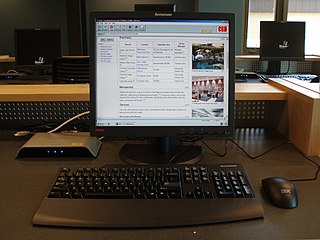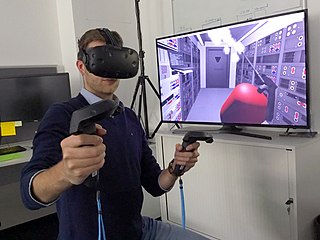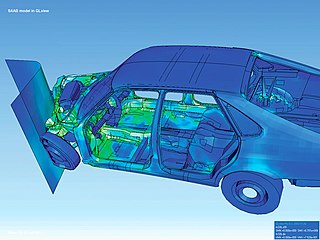Related Research Articles
Multimedia refers to the integration of multiple forms of content, such as text, audio, images, video, and interactive elements into a single digital platform or application. This integration allows for a more immersive and engaging experience compared to traditional single-medium content. Multimedia is utilized in various fields, including education, entertainment, communication, game design, and digital art, reflecting its broad impact on modern technology and media.

In computer networking, a thin client, sometimes called slim client or lean client, is a simple (low-performance) computer that has been optimized for establishing a remote connection with a server-based computing environment. They are sometimes known as network computers, or in their simplest form as zero clients. The server does most of the work, which can include launching software programs, performing calculations, and storing data. This contrasts with a rich client or a conventional personal computer; the former is also intended for working in a client–server model but has significant local processing power, while the latter aims to perform its function mostly locally.

Virtual reality (VR) is a simulated experience that employs 3D near-eye displays and pose tracking to give the user an immersive feel of a virtual world. Applications of virtual reality include entertainment, education and business. VR is one of the key technologies in the reality-virtuality continuum. As such, it is different from other digital visualization solutions, such as augmented virtuality and augmented reality.
Application software is any computer program that is intended for end-user use – not operating, administering or programming the computer. An application is any program that can be categorized as application software. Common types of applications include word processor, media player and accounting software.
A virtual environment is a networked application that allows a user to interact with both the computing environment and the work of other users. Email, chat, and web-based document sharing applications are all examples of virtual environments. Simply put, it is a networked common operating space. Once the fidelity of the virtual environment is such that it "creates a psychological state in which the individual perceives himself or herself as existing within the virtual environment" then the virtual environment (VE) has progressed into the realm of immersive virtual environments (IVEs).

Visualization, also known as Graphics Visualization, is any technique for creating images, diagrams, or animations to communicate a message. Visualization through visual imagery has been an effective way to communicate both abstract and concrete ideas since the dawn of humanity. from history include cave paintings, Egyptian hieroglyphs, Greek geometry, and Leonardo da Vinci's revolutionary methods of technical drawing for engineering purposes that actively involve scientific requirements.
A Rich Internet Application is a web application that has many of the characteristics of desktop application software. The concept is closely related to a single-page application, and may allow the user interactive features such as drag and drop, background menu, WYSIWYG editing, etc. The concept was first introduced in 2002 by Macromedia to describe Macromedia Flash MX product. Throughout the 2000s, the term was generalized to describe browser-based applications developed with other competing browser plugin technologies including Java applets, Microsoft Silverlight.
Desktop Window Manager is the compositing window manager in Microsoft Windows since Windows Vista that enables the use of hardware acceleration to render the graphical user interface of Windows.
VirtualGL (VGL) is an open-source software package that redirects the 3D rendering commands from Unix and Linux OpenGL applications to 3D accelerator hardware in a dedicated server and sends the rendered output to a (thin) client located elsewhere on the network. On the server side, VirtualGL consists of a library that handles the redirection and a wrapper program that instructs applications to use this library. Clients can connect to the server either using a remote X11 connection or using an X11 proxy such as a Virtual Network Computing (VNC) server. In case of an X11 connection some client-side VirtualGL software is also needed to receive the rendered graphics output separately from the X11 stream. In case of a VNC connection no specific client-side software is needed other than the VNC client itself.

Desktop virtualization is a software technology that separates the desktop environment and associated application software from the physical client device that is used to access it.
In computing, 3D interaction is a form of human-machine interaction where users are able to move and perform interaction in 3D space. Both human and machine process information where the physical position of elements in the 3D space is relevant.
Microsoft RemoteFX is a Microsoft brand name that covers a set of technologies that enhance visual experience of the Microsoft-developed remote display protocol Remote Desktop Protocol (RDP). RemoteFX was first introduced in Windows Server 2008 R2 SP1 and is based on intellectual property that Microsoft acquired and continued to develop since acquiring Calista Technologies. It is a part of the overall Remote Desktop Services workload.
VideoOverIP is a remote desktop protocol developed by Texas-based, desktop virtualization and cloud computing company VDIworks.
GPU virtualization refers to technologies that allow the use of a GPU to accelerate graphics or GPGPU applications running on a virtual machine. GPU virtualization is used in various applications such as desktop virtualization, cloud gaming and computational science.
Computation offloading is the transfer of resource intensive computational tasks to a separate processor, such as a hardware accelerator, or an external platform, such as a cluster, grid, or a cloud. Offloading to a coprocessor can be used to accelerate applications including: image rendering and mathematical calculations. Offloading computing to an external platform over a network can provide computing power and overcome hardware limitations of a device, such as limited computational power, storage, and energy.
Visual computing is a generic term for all computer science disciplines dealing with the 3D modeling of graphical requirements, for which extenuates to all disciplines of the Computational Sciences. While this is directly relevant to the software visualistics of Microservices, Visual Computing also includes the specializations of the subfields that are called Computer Graphics, Image Processing, Visualization, Computer Vision, Computational Imaging, Augmented Reality, and Video Processing, upon which extenuates into Design Computation. Visual computing also includes aspects of Pattern Recognition, Human-Computer Interaction, Machine Learning, Robotics, Computer Simulation, Steganography, Security Visualization, Spatial Analysis, Computational Visualistics, and Computational Creativity. The core challenges are the acquisition, processing, analysis and rendering of visual information. Application areas include industrial quality control, medical image processing and visualization, surveying, multimedia systems, virtual heritage, special effects in movies and television, and ultimately computer games, which is central towards the visual models of User Experience Design. Conclusively, this includes the extenuations of large language models (LLM) that are in Generative Artificial Intelligence for developing research around the simulations of scientific instruments in the Computational Sciences. This is especially the case with the research simulations that are between Embodied Agents and Generative Artificial Intelligence that is designed for Visual Computation. Therefore, this field also extenuates into the diversity of scientific requirements that are addressed through the visualized technologies of interconnected research in the Computational Sciences.
Remote mobile virtualization, like its counterpart desktop virtualization, is a technology that separates operating systems and applications from the client devices that access them. However, while desktop virtualization allows users to remotely access Windows desktops and applications, remote mobile virtualization offers remote access to mobile operating systems such as Android.

Kubity is a cloud-based 3D communication tool that works on desktop computers, the web, smartphones, tablets, augmented reality gear, and virtual reality glasses. Kubity is powered by several proprietary 3D processing engines including "Paragone" and "Etna" that prepare the 3D file for transfer over mobile devices.

A virtual reality game or VR game is a video game played on virtual reality (VR) hardware. Most VR games are based on player immersion, typically through a head-mounted display unit or headset with stereoscopic displays and one or more controllers.
Volumetric capture or volumetric video is a technique that captures a three-dimensional space, such as a location or performance. This type of volumography acquires data that can be viewed on flat screens as well as using 3D displays and VR headset. Consumer-facing formats are numerous and the required motion capture techniques lean on computer graphics, photogrammetry, and other computation-based methods. The viewer generally experiences the result in a real-time engine and has direct input in exploring the generated volume.
References
- ↑ "Cisco Visual Networking Index: Global Mobile Data Traffic Forecast Update, 2016–2021 White Paper". Cisco. Retrieved 22 February 2017.
- ↑ Blakley, Jim. "The Visual Cloud Second Wave". IT Peer Network. Intel. Retrieved 22 February 2017.
- ↑ "Cisco Visual Networking Index: Global Mobile Data Traffic Forecast Update, 2016–2021 White Paper". Cisco.com. Cisco. Retrieved 22 February 2017.
- ↑ Sciretta, Peter. "Cool Stuff: A Look at Pixar and LucasFilm's Renderfarms". SlashFilm. Retrieved 22 February 2017.
- ↑ "Media Analytics Product Brief" (PDF). Akamai.com. Akamai Technologies. Retrieved 22 February 2017.